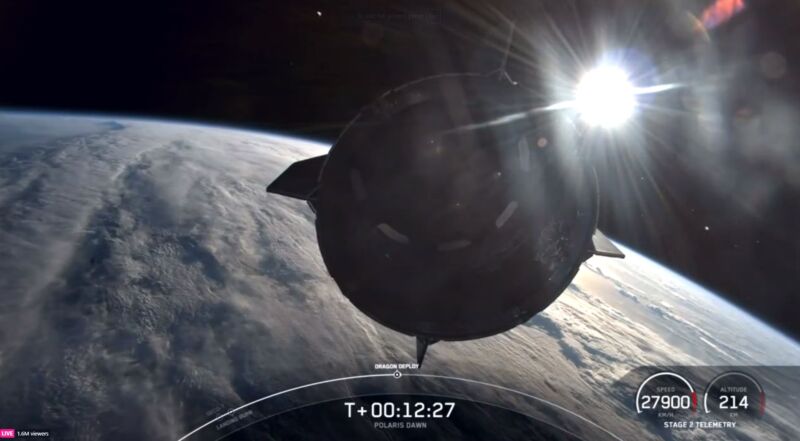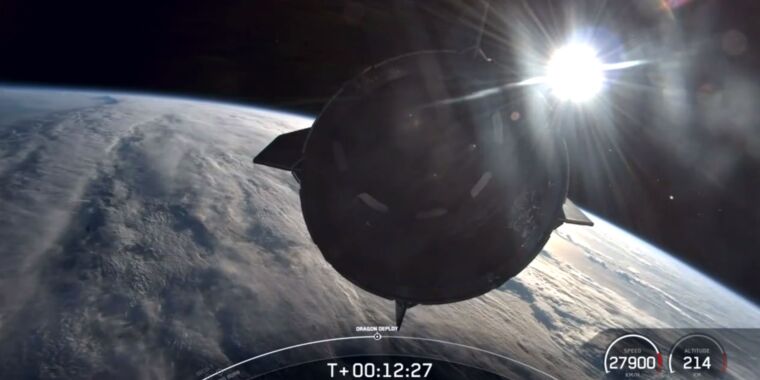
SpaceX
A Falcon 9 rocket streaked through the dark pre-dawn skies over Florida on Tuesday, carrying four people on the most ambitious private spaceflight ever.
The crew of the Polaris Dawn mission, led by a billionaire pilot named Jared Isaacman, was placed into an orbit designed to reach an apogee of 1,200 km and a perigee of 190 km. They plan to raise Crew Dragon’s orbit to an apogee of 1,400 km by the end of the first day of flight.
Shortly after the mission's launch, Isaacman thanked the flight controllers, engineers and technicians at SpaceX who made the privately funded journey possible. “We wouldn't be on this journey without all of you, 14,000 of you at SpaceX,” he said.
At its planned altitude, the mission will be the furthest a human has flown from Earth since the era of Apollo missions to the Moon more than five decades ago. At this altitude, the crew will collect biological data to study the effects of radiation, which is more intense than far from Earth's atmosphere.
When the Dragon Vehicle, called Resistance and making its third flight into space, will descend to a more circular orbit about 700 km above the Earth's surface. From here, probably on the third day of the mission, each of the crew members – Isaacman, Scott “Kidd” Poteet, Anna Menon and Sarah Gillis – will don their spacesuits and the air in the cabin will be vented into space.
Taking a walk through space
First, Isaacman and then Gillis will climb out of the spacecraft for a brief look around. If this moment goes according to plan, it would be historic as the first private spacewalk. Just as importantly, Isaacman’s initiative has accelerated SpaceX’s timeline to develop spacesuits for future missions. This is version 1.0 of a suit that could one day be used by hundreds or even thousands of astronauts walking on the surface of the moon and Mars.
The spacewalk is the centerpiece of the Polaris Dawn mission, but the crew will also conduct numerous science experiments and test Starlink-based space communications.
Depending on weather conditions on Earth, the mission will last up to five days, before the crew returns to the planet and lands in the waters around Florida, either in the Atlantic Ocean or the Gulf of Mexico.
The weather restrictions for these splashdown zones are quite strict, and an added complication of Polaris Dawn is that wind and sea conditions must be accurately predicted five days in advance. If meteorologists are not completely confident in the splashdown weather, the mission cannot launch. The Dragon spacecraft carries a limited amount of food and consumables, so the vehicle has a limited lifespan during a free-flying mission such as this one.
Just wait a little longer to go into space
These weather conditions have plagued Isaacman and his crew for two weeks. The mission was originally scheduled to launch early in the morning of August 27, but had to be delayed a day due to a helium leak in the ground system. After addressing the issue, SpaceX has been searching for good launch and landing weather ever since. The waters around Florida have been choppy, and the pattern has only recently improved.
Finally, SpaceX weather forecasters began to feel confident Monday about conditions for this weekend’s landing. And so the concern turned to the weather at the launch site, with storms moving through Monday afternoon. SpaceX had to pass up its first opportunity Tuesday morning because of nearby rain showers. Nearly two hours later, however, the skies cleared a bit above the pad. At 5:23 a.m. ET, just before sunrise, it was time for Polaris Dawn to fly.
And so the rocket, making its fourth flight into space, did just that. This was, remarkably, SpaceX’s 88th launch of the year, keeping the company on track to break its own record for the most annual launches by any country or company, ever. Now, more history awaits in the coming days.

